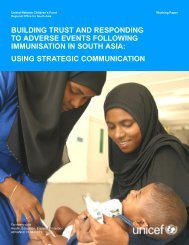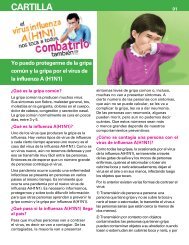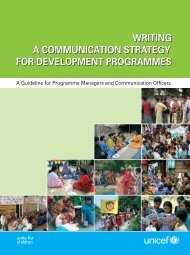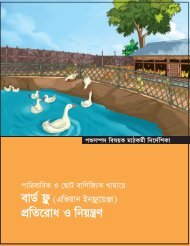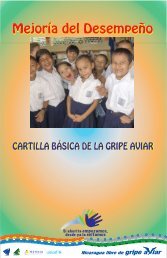FAO-OIE-WHO Joint Technical Consultation on Avian Influenza at ...
FAO-OIE-WHO Joint Technical Consultation on Avian Influenza at ...
FAO-OIE-WHO Joint Technical Consultation on Avian Influenza at ...
- No tags were found...
You also want an ePaper? Increase the reach of your titles
YUMPU automatically turns print PDFs into web optimized ePapers that Google loves.
<str<strong>on</strong>g>Joint</str<strong>on</strong>g> Writing Committeeintroducti<strong>on</strong>s in some areas and <strong>on</strong>going circul<strong>at</strong>i<strong>on</strong> in others)can be used to inform specific animal sector preventi<strong>on</strong>and c<strong>on</strong>trol measures. As well, d<strong>at</strong>a can be used to informpublic health risk assessment. For example, mut<strong>at</strong>i<strong>on</strong>s associ<strong>at</strong>edwith previous human pandemic isol<strong>at</strong>es have beenidentified in these viruses, and adamantane resistance hasalso been identified. These findings were communic<strong>at</strong>ed tothe intern<strong>at</strong>i<strong>on</strong>al public health sector immedi<strong>at</strong>ely afterdetermin<strong>at</strong>i<strong>on</strong>. Improved two-way communic<strong>at</strong>i<strong>on</strong> betweenthe animal and public health sectors regarding which specificmut<strong>at</strong>i<strong>on</strong>s are of public health interest, and which ofthose mut<strong>at</strong>i<strong>on</strong>s are circul<strong>at</strong>ing in animal popul<strong>at</strong>i<strong>on</strong>s,would optimize early detecti<strong>on</strong> of emerging viruses withincreased zo<strong>on</strong>otic or pandemic potential.The importance of system<strong>at</strong>ic m<strong>on</strong>itoring of AIVs forantiviral resistance was stressed. When current antiviralsare no l<strong>on</strong>ger useful against circul<strong>at</strong>ing strains, new antiviralsneed to be developed. Labor<strong>at</strong>ories need to investig<strong>at</strong>enew resistance mut<strong>at</strong>i<strong>on</strong>s by genotypic and phenotypicscreening, flag resistant viruses for tracking, and communic<strong>at</strong>ethese findings readily between the animal and publichealth sectors.Development of a standard H5N1 nomencl<strong>at</strong>ure by thejoint <str<strong>on</strong>g>WHO</str<strong>on</strong>g> ⁄ <str<strong>on</strong>g>OIE</str<strong>on</strong>g> ⁄ <str<strong>on</strong>g>FAO</str<strong>on</strong>g> H5N1 evoluti<strong>on</strong> working group hasprovided both the animal and public health sectors with aphylogenetic classific<strong>at</strong>i<strong>on</strong> system based <strong>on</strong> the HA gene. 5This system improves interpret<strong>at</strong>i<strong>on</strong> of sequence d<strong>at</strong>a fromdifferent labor<strong>at</strong>ories, removes subjective geographical references,allows for expansi<strong>on</strong> as new clades emerge, andprovides a basis for a more extensive system including antigenicvari<strong>at</strong>i<strong>on</strong> and genotyping. Expansi<strong>on</strong> of the system toH9 and SIVs is being planned. It was menti<strong>on</strong>ed th<strong>at</strong> theunified nomencl<strong>at</strong>ure further strengthens pandemic preparednessactivities rel<strong>at</strong>ed to vaccine, antiviral, and diagnostictest development and stockpiling by focusing efforts<strong>on</strong> the most relevant emerging viruses.5 http://www.who.int/csr/disease/avian_influenza/guidelines ⁄ nomencl<strong>at</strong>ure/en/index.htmlAntigenic cartographyAntigenic cartography provides a way to visualize the antigenicevoluti<strong>on</strong> of influenza viruses using HI assay d<strong>at</strong>a. Inantigenic maps, antigenically similar viruses appear closertogether, allowing visualiz<strong>at</strong>i<strong>on</strong> of antigenic changesthrough time and geographical space. The technique wasfirst applied to human H3 virus evoluti<strong>on</strong>, using ferretserumgener<strong>at</strong>ed HI d<strong>at</strong>a from human seas<strong>on</strong>al viruses, andsince 2004 has been effectively used by <str<strong>on</strong>g>WHO</str<strong>on</strong>g> for selecti<strong>on</strong>of human influenza vaccine strains. H5 antigenic cartographyis in the early stages of development for human vaccinestrain selecti<strong>on</strong>, but is also being used for evalu<strong>at</strong>ingavian viruses for animal health sector use. Different p<strong>at</strong>ternsare being seen using the animal health sector HI d<strong>at</strong>a,which may be due to cre<strong>at</strong>i<strong>on</strong> of HI sera in chickens(r<strong>at</strong>her than ferrets) or to using sera raised with adjuvanted(r<strong>at</strong>her than n<strong>on</strong>-adjuvanted) antigens. It was suggestedth<strong>at</strong>, ideally, the antigenic analyses of circul<strong>at</strong>ing strains bythe animal health and public health sectors should be integr<strong>at</strong>ed.Epidemiological and virological surveillance and inform<strong>at</strong>i<strong>on</strong>sharingIn discussi<strong>on</strong>, the importance of strengthening global virologicaland epidemiological surveillance for H5N1 and otheranimal influenza viruses to ensure early detecti<strong>on</strong> of bothdisease and virological changes was str<strong>on</strong>gly emphasized.It was agreed th<strong>at</strong> both the animal and public he<strong>at</strong>h sectorswould benefit from improved knowledge of the propertiesof H5N1 (or other AIVs) th<strong>at</strong> are circul<strong>at</strong>ing inanimals to adequ<strong>at</strong>ely assess which strains should be recommendedfor veterinary and human vaccines and toupd<strong>at</strong>e diagnostic reagents according to genetic and antigenicevoluti<strong>on</strong>. Having a full and broad picture of the distributi<strong>on</strong>and prevalence of viruses and disease globallywould allow better assessments of animal and public healthrisks, as well as the identific<strong>at</strong>i<strong>on</strong> of mut<strong>at</strong>i<strong>on</strong>s of publichealth significance.Surveillance in poultry and wild birds in Europe,North America, H<strong>on</strong>g K<strong>on</strong>g, and other selected loc<strong>at</strong>i<strong>on</strong>sis intensive, but in many areas of AI risk, surveillance isweak or lacking and needs to be supported andimproved in a sustainable way. It was noted th<strong>at</strong> inEurope, existing surveillance has led to early detecti<strong>on</strong> ofH5N1 <strong>on</strong> several occasi<strong>on</strong>s. Currently, the extensiveEuropean d<strong>at</strong>a is maintained in the DG-SANCO d<strong>at</strong>abase,6 and partly (for wild bird isol<strong>at</strong>es) in theEU-funded research project New-Flubird. 7 A comm<strong>on</strong>global pl<strong>at</strong>form and linking of surveillance systems wouldbe ideal, with <strong>on</strong>e c<strong>on</strong>straint being the differences intypes of surveillance am<strong>on</strong>g countries. Improved communic<strong>at</strong>i<strong>on</strong>between existing pl<strong>at</strong>forms would already be apositive step forward.It was recognized th<strong>at</strong> when effective passive and activesurveillance leads to early disease detecti<strong>on</strong>, then diseasec<strong>on</strong>trol is improved. However, effective animal sector surveillancerequires a complete and functi<strong>on</strong>al veterinaryinfrastructure and supporting diagnostic labor<strong>at</strong>ory capacity.As well, effective use of resources requires appropri<strong>at</strong>etargeting (e.g., by species, sector) and implement<strong>at</strong>i<strong>on</strong>according to differing disease p<strong>at</strong>terns (e.g., for sporadicversus endemic disease situ<strong>at</strong>i<strong>on</strong>s). It was recognized th<strong>at</strong>6 DG Sanco d<strong>at</strong>a available <strong>at</strong> http://ec.europa.eu/food/animal/diseases/c<strong>on</strong>trolmeasures/avian/eu_resp_surveillance_en.htm7 New Flubird d<strong>at</strong>a available <strong>at</strong> http: ⁄⁄www.new-flubird.eu ⁄8 ª 2010 <str<strong>on</strong>g>FAO</str<strong>on</strong>g>, <str<strong>on</strong>g>OIE</str<strong>on</strong>g> and <str<strong>on</strong>g>WHO</str<strong>on</strong>g>, <strong>Influenza</strong> and Other Respir<strong>at</strong>ory Viruses, 4 (Suppl. 1), 1–29





